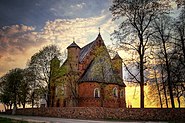A fortified church is a church that is built to play a defensive role in times of war. Such churches were specially designed to incorporate military features, such as thick walls, battlements and embrasures. Others, such as the Cathedral of Ávila were incorporated into the town wall. Monastic communities, such as Lérins Abbey, are often surrounded by a wall, and some churches, such as St Arbogast in Muttenz, Switzerland, have an outer wall as well. Churches with additional external defences such as curtain walls and wall towers are often referred to more specifically as fortress churches or Kirchenburgen (literally "church castles").
A high concentration of fortified churches may be found in parts of Europe where there was a lot of hand-to-hand warfare, for example in the Dordogne region of France, which was fought over by France and England in medieval times, and in Transylvania, which was the scene of Ottoman invasions. Fortified churches were also built in places controlled by colonial empires, such as the one in the Philippines that served as the scene of the Siege of Baler.
Belarus[]
Although a large number of fortified churches in a variety of styles existed in the lands of Belarus only a handful have survived until the present. The most famous include Christian Orthodox churches in Muravanka and Synkovichi, as well as Catholic fortified churches in Kamai and Ishkold'. In addition to Christian churches Belarus also has the ruins of several fortified synagogues, of which the Chief Synagogue in Bykhaw is most notable.[1]
France[]
About 65[2] fortified churches are found in the Thiérache region of France.
Germany[]
There are several fortified churches that have been preserved, especially in the German states of Baden-Württemberg, Bavaria and Hesse. Examples are the churches of Kleinbreitenbach in Plaue, Kößlarn, Grafengehaig, Großrückerswalde, Mittelsaida, Büchenbach/Erlangen, Kriegenbrunn/Erlangen, Morsbach/Künzelsau, Espendfeld/Arnstadt, Finkenbach-Gersweiler, St. Wolfgang in Rothenburg and the fortified church of Wenkbach.
Poland[]
A rare surviving example of a fortress church used for defensive purposes is the Church of St. Andrew in Kraków, one of the oldest and best-preserved Romanesque buildings in Poland. Located at ul. Grodzka street, it was built by a medieval Polish statesman Palatine Sieciech in 1079–1098. St. Andrew was the only Romanesque church in Kraków to withstand the Mongol attack of 1241. Along the lower part of the broader section of its façade are small openings that served as defensive windows during military siege.[3]
Portugal[]
A number of medieval fortified churches, monasteries and cathedrals survive in Portugal. These buildings were built either in Romanesque or Gothic styles. Romanesque examples are the Lisbon Cathedral and the Old Cathedral of Coimbra. Gothic examples are the Church of Leça do Balio and the Guarda Cathedral.
Romania[]
South-eastern Transylvania region in Romania has one of the highest numbers of existing fortified churches from the thirteenth to sixteenth centuries.[4] More than 150 villages in the area count various types of fortified churches, seven of them being included in the UNESCO World Heritage under the name of Villages with fortified churches in Transylvania.
United Kingdom[]
There are medieval fortified churches near the Anglo-Scottish border, where defence was an important consideration until the seventeenth century when the two states were united in personal union. All Saints Church, Boltongate in Cumbria is an example.[5] Also in Cumbria, St Michael's Church, Burgh by Sands has a defensive tower, and originally had two.
Defensive towers can also be found on the England–Wales border, for instance, St Michael's Church, Garway.[6]
Gallery of prominent examples[]
See also[]
| Wikimedia Commons has media related to Category:Fortified churches. |
- Saint Catherine's Monastery
- Tangyud Monastery
- Video Fortified churches in Transylvania
Notes and references[]
- ↑ (Russian) List of fortified churches in Belarus
- ↑ (French) Les Églises fortifiées de la Thiérache - Guide de découvertes / Sites de Mémoire, balades et circuits - Coll. Guide Pays côté Histoire, éd. Chamina, 2006, format 14 x 21 cm, 48 p. - ISBN 2-84466-110-6
- ↑ (Polish) "Kościół św. Andrzeja w Krakowie." Short history and photographs
- ↑ Villages with Fortified Churches in Transylvania. UNESCO World Heritage Centre 1992-2010
- ↑ List of Fortified Ecclesiastical Sites (churches and monastries) in England
- ↑ Resources, www.users.globalnet.co.uk
| |||||||||||||||||||||||
The original article can be found at Fortified church and the edit history here.






















